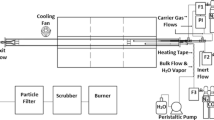Abstract
This paper addresses the thermodynamic aspects of metallic elements (typically Fe, Ni, and Cr) in carburization and metal-dusting processes in CH4–H2, CO–CO2, and CO–H2O–H2 carburizing gas mixtures, and their possible contributions to understanding of carburization and metal-dusting phenomena. Carburization requires \(a_C \left( {gas} \right) > a_C \left( {M_Z C/M} \right) \cdot a_C \left( {M_Z C/M} \right)\) is solely temperature-dependent, while aC (gas) is dependent not only on temperature but also on gas chemistry and total pressure. In general, metallic elements tend to be carburized at higher temperatures in CH4–H2, but at lower temperatures in CO–CO2 and CO–H2O–H2 carburizing gas mixtures. For metal dusting to occur, \(a_C \left( {M_Z C/M} \right)\)(gas)> 1 (first-type) and \(a_C \left( {gas} \right) > a_C \left( {M_Z C/M} \right)\); 1 (second-type) should be satisfied. Possible regimes for first- and second-type metal dusting are discussed for pure Fe and Ni, and the range for first-type metal dusting of Ni is considerably broader than that for Fe.
Similar content being viewed by others

References
H. J. Grabke, Carburization—A High Temperature Corrosion Phenomenon, Chapter one, Part I (Materials Technology Institute, 1998).
R. F. Hochman, Proceedings of the 4th International Congress on Metal Corrosion, N.E. Hammer, ed.(NACE, Houston, 1972), pp. 258–263.
H. J. Grabke and I. Wolf, Materials Science Engineering 87, 23-33 (1987).
A. Rahmel, H. J. Grabke, and W. Steinkusch, Materials Corrosion 49, 221-225 (1998).
H. J. Grabke, R. Krajak, and J. C. Nava Paz, Corrosion Science 35, 1141-1150 (1993).
J. C. Nava Paz and H. J. Grabke, Oxidation of Metals 39, 437-456 (1993).
E. Pippel, J. Woltersdorf, H. J. Grabke, and S. Strauß, Steel Research 66, 217-221 (1995).
E. Pippel, J. Woltersdorf, and R. Schneider, Materials Corrosion 49 309-316 (1998).
R. Schneider, E. Pippel, J. Woltersdorf, S. Strauß, and H. J. Grabke, Steel Research 68, 326-332 (1997).
C. M. Chun, J. D. Mumford, and T. A. Ramanarayanan, Journal of Electrochemical Society 147, 3680-3686 (2000).
C. M. Chun, J. D. Mumford, and T. A. Ramanarayanan, Journal of Electrochemical Society 149, B348-B355 (2002).
C. M. Chun, T. A. Ramanarayanan, and J. D. Mumford, Materials Corrosion 50, 634-639 (1999).
R. Yin, Oxidation of Metals 60, 103-116 (2003).
O. Kubaschewski and C. B. Alcock, Metallurgical Thermo-chemistry, 5th ed. (Pergamon Press Ltd, 1979).
S. R. Shatynski, Oxidation of Metals 13, 105-118 (1979).
JANAF Thermodynamic Data (Dow Chemical Co., Midland, Mich., 1960–1961).
M. Maier, J. F. Norton, and P. D. Frampton, Materials Corrosion 49, 330-335 (1998).
T. P. Levi, N. Briggs, I. Minchington, and C. W. Thomas Paper 01375, NACE, Corrosion, 2001.
Author information
Authors and Affiliations
Rights and permissions
About this article
Cite this article
Yin, R. Thermodynamic Roles of Metallic Elements in Carburization and Metal Dusting. Oxidation of Metals 61, 323–337 (2004). https://doi.org/10.1023/B:OXID.0000025338.74215.31
Issue Date:
DOI: https://doi.org/10.1023/B:OXID.0000025338.74215.31



